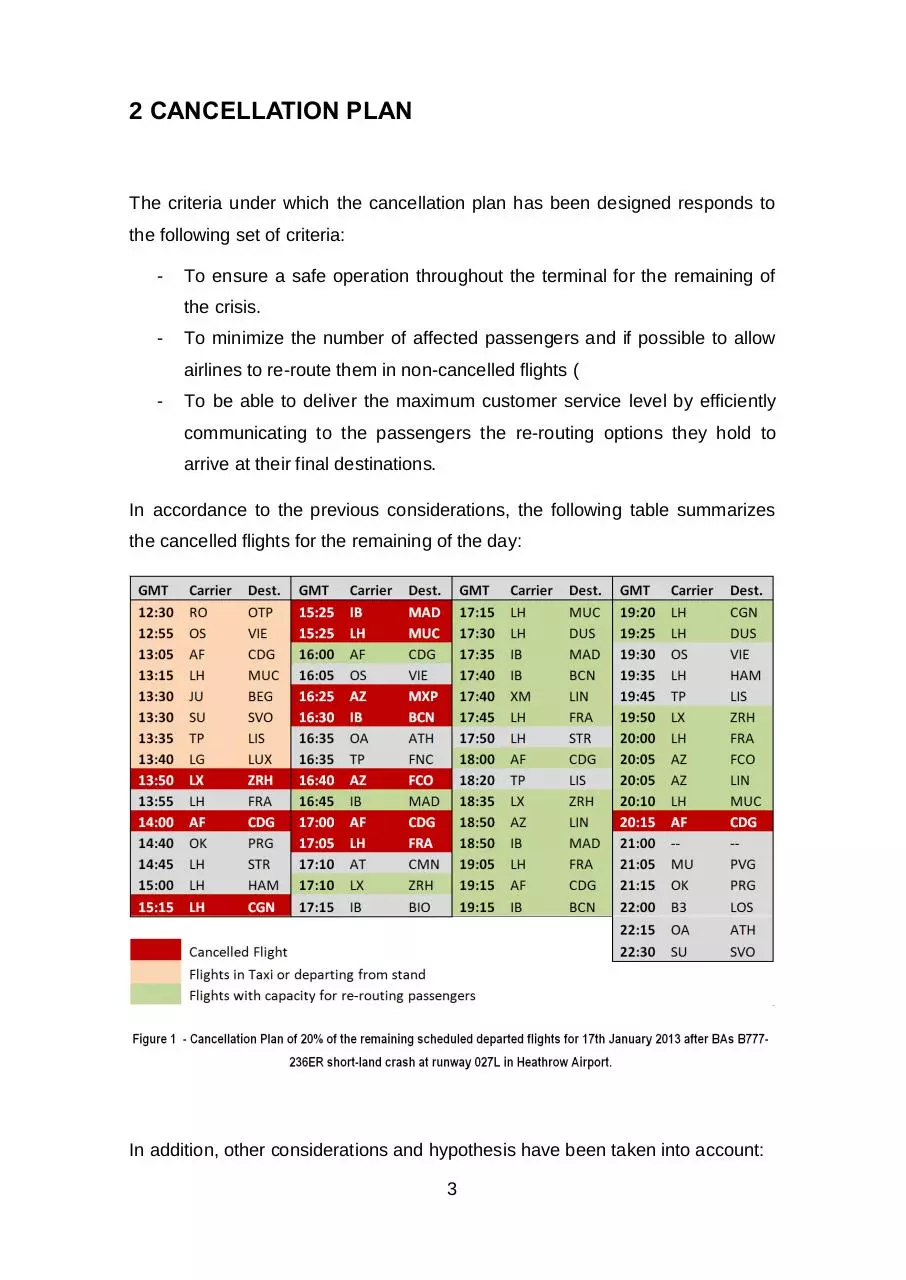TDM Reaction Plan to B777 Crash 17Jan2008 (PDF)
File information
Title: _
Author: "%username%"
This PDF 1.5 document has been generated by Microsoft® Word 2010, and has been sent on pdf-archive.com on 03/01/2014 at 12:14, from IP address 83.47.x.x.
The current document download page has been viewed 792 times.
File size: 751.41 KB (16 pages).
Privacy: public file





File preview
CRANFIELD UNIVERSITY
School of Engineering, Centre for Air Transport
MSc Airport Planning and Management
David Ruiz-Celada
S203000
Airport Operations:
Terminal Duty Manager Reaction Plan to B777236ER short landing in Heathrow Airport as in
17th January 2008
2013-2014
Supervisor: Rich Moxon
25.11.2013
Word Count: 2993
1
1 INTRODUCTION
This paper is based in the scenario occurred as in 17thJanuary2008, London
Heathrow Airport, when a B777-236ER short landed and crashed right upon the
threshold of RWY027L. An efficient and though reaction by the TDM (and all the
T2 staff) to the situation is required, in order to minimize the consequences of
the event. Due to capacity constraint, a 20% of the remaining scheduled flights
of the day departing from T2 must be cancelled, and this is most likely to cause
confusion, passenger accumulation in ground levels landside and forecourts
and a lot of tension between the costumers and the airport staff. Keeping
passengers well informed on the situation of their flights and re-routing options
will be key to reducing overall stress levels. Communicating with airlines in
order to obtain information on delayed and/or cancelled flights is a key aspect to
consider to planning accordingly and containing the extent of the crisis.
Therefore, the initial cancellation plan is the base on which the action plan of
the TDM
1
will be executed. The final aim is to deliver good service quality,
considering the nature of the events by achieving a maximum of passengers to
final destination as possible by the end of the day.
1
Terminal Duty Manager
2
2 CANCELLATION PLAN
The criteria under which the cancellation plan has been designed responds to
the following set of criteria:
-
To ensure a safe operation throughout the terminal for the remaining of
the crisis.
-
To minimize the number of affected passengers and if possible to allow
airlines to re-route them in non-cancelled flights (
-
To be able to deliver the maximum customer service level by efficiently
communicating to the passengers the re-routing options they hold to
arrive at their final destinations.
In accordance to the previous considerations, the following table summarizes
the cancelled flights for the remaining of the day:
In addition, other considerations and hypothesis have been taken into account:
3
-
Cancellations of medium/long haul flights to be avoided for being more
sensitive to a lack of frequency and re-routing options.
-
To avoid cancellations of single-flight destinations.
-
To avoid cancellations of flights with declared load factors of >90%.
-
As a hypothesis, non-declared load factor flights have been considered
to be at a value of 80%. This LF may vary when the airlines team speaks
with the airlines, but at the moment the conservative assumption must be
made.
The following figures show the distribution by carrier and destination of the
cancellation plan:
4
As it can be observed from Figures 2 and 3 and the above Figure1,
cancellations have been distributed accordingly to the criteria of ensuring a safe
and optimal response of the terminal to the situation by allowing a high degree
of re-routing options. Also, the cancellations are coherent with the amount of
flight remaining for each carrier. The only case in which all flights to one
destination have been cancelled is MXP, but passengers can be re-routed via
LIN with the same carrier. This re-routing consideration has also been
considered in DUS and CGN, both destination operated by LH. Moreover, CDG
presents the highest amount of cancellations. This is justified by the fact that it
is the most frequently scheduled route and it is also the easiest destination to
cover by alternative means other than air. The following figure shows those
routes affected by the cancellation plan.
2.1 CONSEQUENCES OF THE CANCELLATION PLAN
Considering the presented set of cancellations, it is clear that the critical timeframe will in the mid-afternoon between 1215UTC to 1700UTC approximately.
This estimation has been made considering that most of the passengers for
short-haul routes will arrive between two and one hour prior to their flights, and
it is presumable to assume that most of the passengers will get to the airport as
soon as possible to check the status of their flight since the media coverage on
5
the event is ensured to be extensive. A graphic representation of the volume of
passengers arriving to the Terminal throughout the expected busy cancellation
timespan is shown in Figure5 below.Figure6 shows an overview of the expected
scenario of accumulated passengers in the terminal with cancelled flights and
the capacity of re-routing for these passengers. In the end, it can be expected
that if instructions and communication are executed precisely, most of the
passengers will meet their final destination. This idea defines the strategy of the
action plan.
6
3 INCIDENT RESPONSE
Once the cancellation plan has been set, the action plan can be developed. The
action plan is intended to be consistently coherent with the assumption that the
terminal will get crowded both before and after the security check. For this, the
action plan considers all the immediate and mid-term actions to be taken in
order to control the flows of passengers. Since the peak of accumulated
passengers is expected around 1700UTC (Figure6), the reaction must be
efficient but be able to adapt in case new events unfold (i.e. more cancellations,
longer than expected delays). A meeting has been set at 1530UTC with all the
Duty Managers to evaluate the situation and take further actions or
modifications to the terminal strategy. Throughout the action plan, several
stakeholders must be approached in order to efficiently coordinate the response
of the terminal as a one. The following sections describe the key points to
consider when dealing with them.
3.1 ACTION PLAN and STAKEHOLDER IMPLICATIONS
Aimed goals of the action plan:
To arrange the possible means by which the highest amount of passengers are able to meet
their final destination, thus limiting the consequences of the crash to the day.
To permit non-cancelled flight passengers to undertake all the departure steps without major
constraints by the cancelled flight passengers.
To provide the maximum level of service quality and safety by responding and managing the
passengers through the terminal in an informed way.
To reduce the impact of the passenger accumulation in the terminal with especial emphasis on
cleaning services, PRM assistance, and flawless communication with stakeholders.
To provide the adequate spaces for passengers waiting for their flights.
To reduce the overall stress levels of the passengers related to delays, the crash itself, or
other factors of the day.
Delegated
Time
responsibility Intended outcome of the
Related
Action to be taken
Stakeholder
UTC
and
action
Manpower
1300Submission of T2 cancellation
To have an estimate of the
2
TDM
ASM
1300
plan.
passenger volumes.
Emit a press note highlighting
To make people aware of
the cancelled flights in T2 and
the situation and be able to
remarking the importance for
1305anticipate as much as
affected passengers to arrive to
TDM
1305
possible the effects of the
the terminal with time to check
cancellations for the
for re-routing or contact with
passengers.
airline if they do not wish to fly.
2
Airline Station Management
7
13101330
13101330
Locate sensible areas of the
terminal from which the crash
site can be seen and assess on
areas to cover. Change TV to
non-reporting channels.
Contact with cancelled flight’s
Airlines Station Managers.
13301900
Re-adjust RMS output according
to expected volumes of
accumulated passengers.
13301400
Contact 1350UTC and 1400UTC
flights carriers, LX and AF,
regarding the passenger reallocation and information.
To avoid local constraints
and potential causes for
increased stress to the
passengers.
TCS
TDM
To justify the cancellation
plan decision and obtain
specific LF information in
order to re-route
passengers.
ASM
SDM
Anticipate the expected
queues that will form in the
security check area and
increase the overall
security presence within the
terminal.
TS
Efficient communication by
the flight gate to re-allocate
the passengers as soon as
possible to 1600UTC and
1710UTC flights.
ASM
Avoid a likely-to-be high
amount of passengers
without bags and a lot of
bags without passengers
situation, created by the
confusion of having most of
the passengers airside
when the cancellation is
done.
TCS
Allow better passenger
flows in and out the T2.
TE
Avoid constraint of
passenger flows out of the
security check to achieve a
decrease in their stress.
This will help increasing
retail although the
circumstances of the day.
RO10
SC /TCS
CSDM
5
TDM-CSDM
13351400
Ensure that baggage of
1350UTC and 1400UTC flyers is
successfully re-allocated and/or
sent to baggage claim zone.
BDM
7
13451345
Check if the rotatory entrance
door which is out of service can
be fixed or opened.
EDM
8
13502000
Call for priority clearance of the
retail area.
3
TDM–CSDM
3
Customers Service Duty Manager
Terminal Customer Service
5
Security Duty Manager
6
Terminal Security
7
Baggage Duty Manager
8
Engineering Duty Manager
9
Terminal Engineering
10
Retail Operation – Shops and Catering
4
8
4
6
9
13552000
Set information points (staff)
allocating people in seating
rooms, gates, etc.[7]
13552000
Set up an auxiliary information
desk in the entrance of T2
informing on cancellations,
passenger rights, and
alternatives for each
destination.[6][2]
CSDM–FDO
14002000
Set “zig-zag” lane separator
around airlines information
desks and ticket sale points.[3]
CSDM–FDO
14052000
Set an information point for
arriving passengers [5] before
they leave the baggage claim
area.[1]
14102000
Call upon PRM services to
anticipate arrivals of disabled
passengers and make them
aware of the cancellation
situation and what options their
passengers hold.
14151415
Submit a request for increased
police presence 1600 and 1800
UTC.
14202000
11
12
Place an additional boarding
pass check before the security
check [4].
CSDM–SDM
11
Avoid congested areas in
the main passenger flow
areas of the terminal.
TCS
Give a first ensured
impression to passengers
who will be arriving with or
without knowledge of the
unfolded events.
LO
To provide immediate
ordered assistance by the
airlines to their customers
and re-allocate as much
fliers as possible.
12
LO/TCS
CSDM–FDO
Avoid as much mixing
between departing and
arriving flows of
passengers.
LO/TCS
CSDM
Ensure that disabled
passengers can get
through the expected crowd
of cancelled passengers
without major problems.
(EU 1107/2006, art 7.1).
TCS
CSDM
Increase security presence
during the expected peak
hours of accumulated
passengers.
TCS
SDM
Floating Duty Officer
Landside Operations
9
It is possible that the
confusion may drive
passengers to attempt to
go airside without having
checked their flight status.
This way the narrow area of
the security check will not
get obstructed.
TCS
Download TDM Reaction Plan to B777 Crash 17Jan2008
TDM_Reaction_Plan_to_B777_Crash_17Jan2008.pdf (PDF, 751.41 KB)
Download PDF
Share this file on social networks
Link to this page
Permanent link
Use the permanent link to the download page to share your document on Facebook, Twitter, LinkedIn, or directly with a contact by e-Mail, Messenger, Whatsapp, Line..
Short link
Use the short link to share your document on Twitter or by text message (SMS)
HTML Code
Copy the following HTML code to share your document on a Website or Blog
QR Code to this page

This file has been shared publicly by a user of PDF Archive.
Document ID: 0000140765.